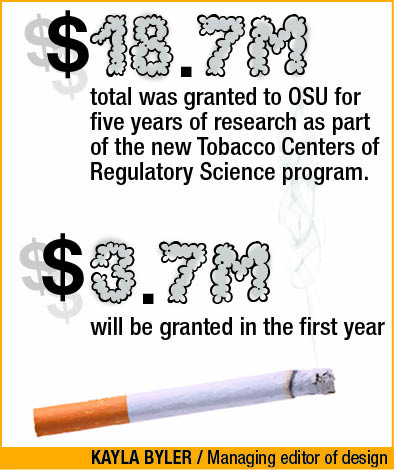
Ohio State will be receiving an $18.7 million grant from the U.S. Food and Drug Administration to study tobacco use and regulation.
OSU was one of 14 research centers chosen to conduct studies as part of the new Tobacco Center of Regulatory Science program. Each of the 14 centers will have a different area of focus.
The OSU Center of Excellence in Regulatory Tobacco Science will be working to understand the reasons for some people’s varying tobacco-product preferences.
“The FDA released a list of 56 research questions that they wanted answered and we chose to focus on understanding the diverse products that are used by the consumer,” said Mary Ellen Wewers, professor of health behavior and health promotion, as well as the principal investigator of the research at OSU.
According to Wewers, the government wanted centers that could quickly assemble their research teams, get out in the field, conduct the studies and provide them with evidence. OSU fit the bill.
“We have a strong tradition of tobacco control research. We have already existing scientists who work in the area of tobacco control,” Wewers said. “(The FDA is) looking for science research studies that can support their policies and decisions they want to make on how we should be regulating tobacco products.”
The other 13 centers selected to receive grants included University of Vermont, Georgia State University, University of Pennsylvania, Yale University, University of North Carolina at Chapel Hill, University of Maryland, College Park and University of Southern California, Los Angeles.
The research will be conducted over the next five years by a group of four product leaders including Wewers, Peter Shields, deputy director of the OSU Comprehensive Cancer Center, Amy Ferketich, associate professor of epidemiology in the College of Public Health, and Ellen Peters, an associate professor of psychology, Wewers said. Each of the four scientists will be hiring teams of researchers to help facilitate the studies.
One of the experiments that will be conducted involves studying boys between the ages of 11 and 14. Researchers plan to find out when they might start using tobacco and what types of products they prefer.
“We are doing a cohort of boys and their families who live out in the rural Appalachian part of Ohio and here in Columbus,” Wewers said. “We are looking to see if the environment makes a difference in what kind of products that adolescents choose to consume. Is there a cultural difference based on your social and cultural environment in the country versus here in Columbus?”
Another study is the effect of different tobacco ads on teenagers and adults.
“Part of my study is going to be following adults and what products they use,” Wewers said. “For example, are they deciding to try an electronic cigarette, thinking that this might help them quit? We want to know over the long run, does it really help them quit or does it allow them to persist using electronic cigarettes alongside the regular tobacco products?”
Researchers hope evidence given to the FDA will help the FDA better regulate tobacco products and will assist it in being able to better inform consumers about the health effects of using different products as new products, such as tobacco-dissolvable lozenges and even tobacco-toothpicks. Wewers said
“Most people who do use tobacco want to quit. They are addicted and have tried to quit. About 50 percent of (tobacco users), on average, will try to quit using tobacco every year,” Wewers said. “We want to be able to provide information that may help them in the long run give up tobacco. It’s expensive and it has bad effects on people’s health.”
Some OSU students felt the new center is a good idea.
“I think it’s great,” said Molly McDonald, a fifth-year in fashion merchandise and non-smoker. “People need to know more about that stuff because I don’t think a lot of people really know about tobacco and what it can do to your health.”
McDonald also said she thinks once more people find out about the study, the level of effectiveness will increase. The ban of smoking on campus also adds to the level of awareness, she said.
The OSU tobacco-ban was voted into effect in April by the Board of Trustees and was set to take effect Aug. 1. Enforcement, however, has since been delayed to 2014.
Kyle Riley-Hawkins, a third-year in construction system management who does not smoke, also said the research was a good idea.
“I feel like it will help and definitely be beneficial. It is a good thing that we are doing this,” Riley-Hawkins said. “People might read the research and understand what it (using tobacco) is doing to their body.”
While the research might be a good idea, Riley-Hawkins said he is skeptical it will have any effect on current users.
“The people who are already doing it (using tobacco), I don’t think they are going to stop,” Riley-Hawkins said. “It might prevent people from starting to use (tobacco), but addicted people won’t stop unless they get treatment or really want to stop.”
The research is funded through the National Institutes of Health in a partnership with the FDA. OSU will receive $3.7 million during the first year of research with a total of $18.7 million to come over the course of five years. The 14 centers will be awarded a total $273 million for the first five years.


